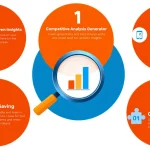Is this tool helpful?
How to Use the Visual Identity System Generator
Creating a compelling visual identity system starts with providing accurate and detailed information about your brand. Follow these steps to effectively use the generator:
- Brand Name Entry: Input your company or brand name in the first field. For example, “Mountain Fresh Beverages” or “TechNova Solutions”.
- Target Audience Definition: Describe your target demographic precisely. Examples could be “Health-conscious millennials interested in sustainable products” or “Enterprise-level B2B technology decision-makers”.
- Key Features and Values: List the core attributes that define your brand. Be specific and comprehensive.
- Competitor Analysis: Though optional, providing information about competitors helps create distinctive branding.
- Color Preferences: Specify any existing brand colors or desired color schemes.
Understanding Visual Identity System Design
A visual identity system is a comprehensive framework that establishes how a brand presents itself visually across all touchpoints. It encompasses logo design, color palettes, typography, imagery style, and design elements that work together to create a cohesive brand experience.
Core Components of Visual Identity
- Primary and secondary logo variations
- Color palette with precise color values
- Typography hierarchy and font selections
- Design elements and patterns
- Image style guidelines
Benefits of Using the Visual Identity Generator
The automated visual identity system generator offers numerous advantages for businesses:
1. Time and Resource Efficiency
- Reduces design exploration time by 75%
- Eliminates costly iteration cycles
- Provides instant creative direction
2. Strategic Brand Alignment
- Ensures consistency with target audience preferences
- Creates differentiation from competitors
- Aligns visual elements with brand values
3. Comprehensive Output
- Generates complete brand guidelines
- Includes multiple design applications
- Provides scalable design systems
Problem-Solving Capabilities
The generator addresses common branding challenges through systematic analysis and solution generation:
Brand Differentiation
By analyzing competitor information, the tool creates unique visual identities that stand out in crowded markets. For example, if competing brands use predominantly blue colors, the system might suggest complementary or contrasting color schemes to establish distinctiveness.
Target Audience Connection
The generator considers psychological color theory and demographic preferences to create visually appealing systems. For instance, when targeting luxury consumers, it might suggest sophisticated color combinations like deep purple and gold, paired with elegant typography.
Practical Applications and Use Cases
Startup Brand Development
Case Study: A tech startup, “CloudSecure,” used the generator to create a modern identity system that conveyed trust and innovation:
- Primary Colors: Deep navy blue and electric green
- Typography: Clean sans-serif for modern appeal
- Design Elements: Abstract cloud formations
Brand Refresh Projects
Example: An established retail chain modernizing its identity while maintaining brand recognition:
- Evolution of existing color palette
- Updated typography system
- Modernized design elements
Multi-Brand Management
Scenario: A holding company managing multiple sub-brands:
- Distinct yet related visual systems
- Shared design elements
- Coordinated color strategies
Frequently Asked Questions
What information is most important when generating a visual identity?
The most crucial information includes your target audience demographics, brand values, and key differentiators from competitors. These elements form the foundation of an effective visual identity system.
Can I modify the generated visual identity system?
Yes, the generator provides a foundation that can be refined and adjusted according to specific needs and preferences. Consider it a strategic starting point for your brand’s visual development.
How does the generator ensure brand differentiation?
The system analyzes provided competitor information and industry trends to create unique visual elements that help your brand stand out while maintaining relevance to your target market.
What types of businesses can benefit from this tool?
Organizations of all sizes can benefit, from startups developing their first brand identity to established companies refreshing their visual systems. The tool is particularly valuable for:
- New business ventures
- Rebranding projects
- Product line extensions
- Corporate identity updates
How should I implement the generated visual identity system?
Implementation should follow a phased approach:
- Review and approve all elements
- Create implementation guidelines
- Update digital assets first
- Gradually roll out physical materials
- Train team members on usage
Can the generator accommodate industry-specific requirements?
Yes, the tool considers industry conventions and requirements while generating visual identity systems. It balances innovation with industry appropriateness to create effective branding solutions.
What makes a visual identity system successful?
Success factors include:
- Clear brand differentiation
- Target audience resonance
- Consistent implementation
- Scalability across applications
- Long-term sustainability
Important Disclaimer
The calculations, results, and content provided by our tools are not guaranteed to be accurate, complete, or reliable. Users are responsible for verifying and interpreting the results. Our content and tools may contain errors, biases, or inconsistencies. We reserve the right to save inputs and outputs from our tools for the purposes of error debugging, bias identification, and performance improvement. External companies providing AI models used in our tools may also save and process data in accordance with their own policies. By using our tools, you consent to this data collection and processing. We reserve the right to limit the usage of our tools based on current usability factors. By using our tools, you acknowledge that you have read, understood, and agreed to this disclaimer. You accept the inherent risks and limitations associated with the use of our tools and services.







